Gumarcaj, sometimes rendered as Cumarcaj or Kumarcaaj is an archeological site in El Quiche department of Guatemala. Gumarcaj is also known as Utatlan, the Nahuatl language name for the city. The name comes from K'iche' Q'umarkah "Place of old reeds". Gumarcaj was the capital city of the Quiche Maya people in late Pre-Columbian times. The ruins of the city are a short distance from the modern city of Santa Cruz del Quiche. Before the Spanish invasion in 1524, the city was known as Utatlan, which is a rough translation of the native K'ichee' toponym. The earliest reference to the site in Spanish occurs in Hernan Cortes' letters from Mexico. The site was founded around 1400 C.E. for its defensive position, as it was a time of warfare in the Guatemala highlands. The city is situated on a hilltop surrounded by ravines. The Spanish Conquistadores overtook the city in 1524. On Alvarado's orders, the city, together with the ruling nobles, were burned. By that time, the Spanish Conquistador Pedro de Alvarado's Spanish soldiers arived an even larger army of indigenous allies and draftees had already defeated the defenders. Cut stone originally facing the buildings was taken to build the new buildings of Santa Cruz del Quiche; the ruins were still being mined for construction material through the late 19th century, doing extensive damage to the remains of the old buildings. The site was extensively documented in the colonial era. Miguel Rivera y Maestre wrote a report of the site for the government of Guatemala in C.E. 1834. In C.E. 1840 it was visited by travel writer John Lloyd Stephens. A more detailed plan of the site was made by Alfred P. Maudslay in C.E.1887. Archeological excavations were made in the 1950s and the 1970s. The site can be visited, although little restoration work has been done to it. Various temple pyramids, the remains of palaces (mostly reduced to mounds of rubble) and a court for playing the Mesoamerican ballgame can be seen. In addition, a series of three caves dig straight into the limestone exact to one end of the site. The first and most extensive cave is about 30 meters long with various altars carved into the rock inside.Some modern Quiche, although officially Christian, still burn candles and incense at the ruined temples.

Copyright: © 1999 thru 2021. All the content; content being images, statements and writing of this website including E-Book are the copyright of Freedom8.net and Walter F. Petrucci, West Hurley, New York.
All rights expressly reserved and as such, protected by U.S. and International Copyright Laws. Design by freedom8 webmaster Version8.




 1
1 2
2 3
3 4
4